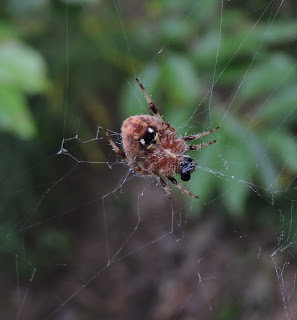Among the largest and most commonly seen spiders in the Fall are the Spotted Orbweavers (Neoscona crucifera and less commonly Neoscona domiciliorum). With webs that can be over 2 feet wide and their tendency to attach them at just above eye level to structures such as buildings, these seem to call attention to themselves this time of year.
During the earlier part of the year you likely never noticed them. Not only were they much smaller as spiderlings, but they hide during the day. They would tear down and consume their webs every morning, so you often didn't notice their webs they constructed nightly. They did this to avoid daytime predators such as birds or wasps from finding them. Mud Dauber wasps for example often sting and paralyze many of these when they're young, stashing them in their mud nests as living paralyzed food for their own babies.
But by Fall, they're often too big for wasps to eat. Many wasps have also concluded hunting and egg laying by this late in the year. So the spiders sometimes hang out during the day. Many birds also don't go after them as much, having no babies to feed or they themselves leaving on migration South. Prey also gets scarcer as it gets colder, so leaving the web up during the warmer day increases the chance of a catch. Consequently, Spotted Orbweavers don't hide as much and also don't tear down their webs and rebuild them at night as much once autumn arrives.
So while there are definitely fewer of them around, they're bigger and hide less. They also often choose to build their webs around our porch lights and buildings, as the artificial lighting attracts insect food to get snared in their webs. They now stay out more often and tear their webs down less, all the way until the first few frosts kill the adults. Their webs are good at intercepting all sorts of aerial or jumping prey.
 |
| A Spotted Orbweaver captures a katydid. |
Spotted Orbweavers and other members of their Genus Neoscona (which mostly look similar) are sometimes called Barn Spiders. That name however is better applied to another large orbweaving spider, Araneus cavaticus. They look quite similar but these are much less common in the DC region. They have wider "shoulder" and lack the broken "L" shape (the spots that give them their names) on their abdomens that Spotted Orbweavers posses.
 |
| A look at the spots on the belly of a Spotted Orbweaver in a broken "L" shape that gives them their name. |
Their scientific name has interesting origins. Eugene Simon, the person who named the Genus as Neoscona in 1864, was just 16 years old when he did so and not good at speaking Greek. Finding one "in the reeds spinning a web", he meant to say just that, but instead the name he gave it translates to "spinning a reed." Despite the goof, the Neoscona name stands. The specific epithet "crucifera" means "cross bearer" due to the shape the markings often take. Some call it a Hentz Orbweaver Spider as the person finding this particular species was named Hentz. In fact the previous accepted scientific name for it use to be Neoscona hentzii. To make names even more confusing, another very similar spider, Nescona domicilorum ( meaning "house dweller"), which is a bit more brightly colored and has other difficult to see differences is also called the Spotted Orbweaver. Luckily as far as life style, they both are much the same so what I write here pretty much holds for both.
 |
| A Spotted Orbweaver hangs head down in its web at night. |
These are large spiders and so easily seen in the Fall near our buildings and sometimes causing concern. But they are relatively harmless to people, only biting under duress. Though almost all spiders have venom, many cannot even break the skin. This one does get large enough to potentially do so, but a bite is rare and supposedly only results in a tiny bit of temporary pain or maybe swelling.
The web, as mentioned, is generally 5-8 feet high and often 2 feet across. They often use existing structures like buildings for support. Other wise they're a typical orb web, with concentric circles and with sticky spoke web connections. The spider hangs head down in the middle when hunting (though they can hide in a corner or in a folded leaf when scared, making use of the hidden retreat). While both males and females make webs when young, the males stop making them when they become adults and instead go in search of a female.
Once they mate, females usually lay a single egg sac holding about a 1000 eggs that is commonly hidden nearby in a folded leaf or other cover. There they overwinter and baby spiderlings are born in the spring, often throwing silk into the air to parachute away and create their own orb webs.
I get many inquiries about these spiders "showing up" by porch lights and buildings in the Fall, the people not knowing the spider has been hiding there all summer, venturing out at night to build its web before recycling it by eating it in the morning. It's only now that people notice these larger adult orbweavers, not realizing they benefited from the spiders catching prey the whole summer long, never causing a problem and very unlikely to cause any now.
 |
| A Spotted Orbweaver near its retreat, or hide, a curled leaf shelter hanging from its web. |

I just saw one this evening! And I had never seen one before the fall came
ReplyDeleteI really like you post good blog,Thanks for your sharing.
ReplyDeleteทางบ้าน